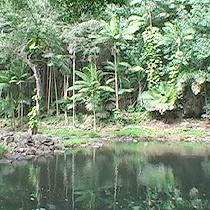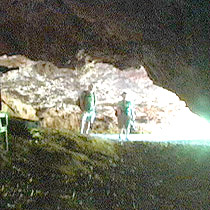2007年VOA标准英语-Hawaii Considered America's Endangered Species
搜索关注在线英语听力室公众号:tingroom,领取免费英语资料大礼包。
(单词翻译)
By Zulima Palacio
Kauai, Hawaii
18 June 2007
The Hawaiian archipelago represents the most isolated1 group of islands in the world. Plants and animals that are common to many people elsewhere only made it to these islands in the last few hundred years -- most of them, only in the last few decades. The introduction of thousands of new species, together with increased human activity, have put many Hawaiian species on the endangered list. Producer Zulima Palacio spent a week with a group of scientists who are trying to save Hawaii's bio-diversity. Rosanne Skirble narrates2 the story.
 |
||
"I think hospice training would probably help us,” he says, “because we are doing what is called the plant extinction prevention programs and so all the plants in that program, 120 species, have less than 50 individuals."
Perlman works as a field researcher for the U.S. National Tropical Botanical Garden on the island of Kauai. He is an authority on Hawaiian flora5. He has discovered nearly 30 species and has rediscovered 20 or more that were thought to be extinct. "I have gone back and actually witnessed extinction at least a dozen times, when I go back and the last one is dead. The first time we kind of took our hats off and had a moment of silence."
But he says now the rate of extinction is more common and Hawaii has become "the endangered species capital of the United States."
 |
| Large caves on the island of Kauai contain a "library" of information about extinct native plants and animals |
Another Tropical Botanical Garden scientist, Michael Wysong, explains why invasive species are a problem. "Everything behind me is schefflera, what some people call octopus8 trees. This invasion occurred in the last 25 years."
Wysong says schefflera, along with the African tulip and the Waiawi Brazilian tree, have taken over much of Hawaii's natural forest. Their dense9 root system prevents the native plants from growing.
Still another Botanical Garden scientist, Dave Burney, has studied the Makauwahi Sinkhole, a set of caves and passages that have turned out to be an important archeological site. "About 400 years ago there was a mega tsunami10 here, some kind of humongous wave that came over this wall and brought huge rocks not associated with the cave environment."
Burney and his wife Lida have worked in the cave for the past 14 years, sifting11 through mounds12 of sediments13. They have found bones of extinct animals and plants. They have found seeds that allowed them to bring back plants that had disappeared. Their findings have allowed him to rewrite some of the natural history of Hawaii.
The director of education for the gardens, Gaugau Tavana, explains why it is important to involve the entire community in trying to maintain nature's balance.
"We are stewards14 of the land. Stewards of nature and the natural resources that have been given to us; and we are only here for a short period of time. We are going to leave and pass it on to next generations. The question is, what we are going to leave to others to come," asks Tavana.
Holding on to traditions, medicinal plants and hundreds of plants forgotten by many, the Tropical Botanical Garden continues its efforts to save and preserve nature as it was in the past, for many generations to come.
 收听单词发音
收听单词发音 




